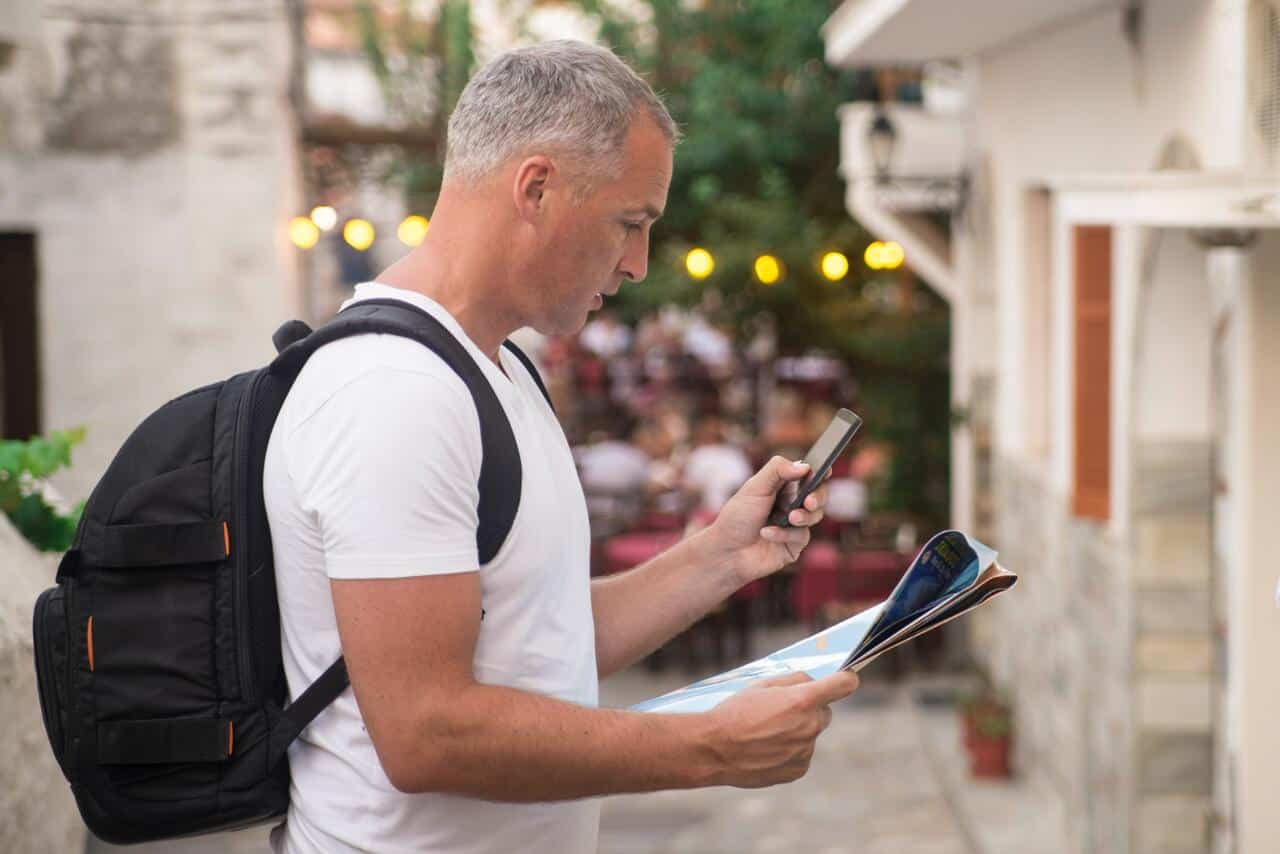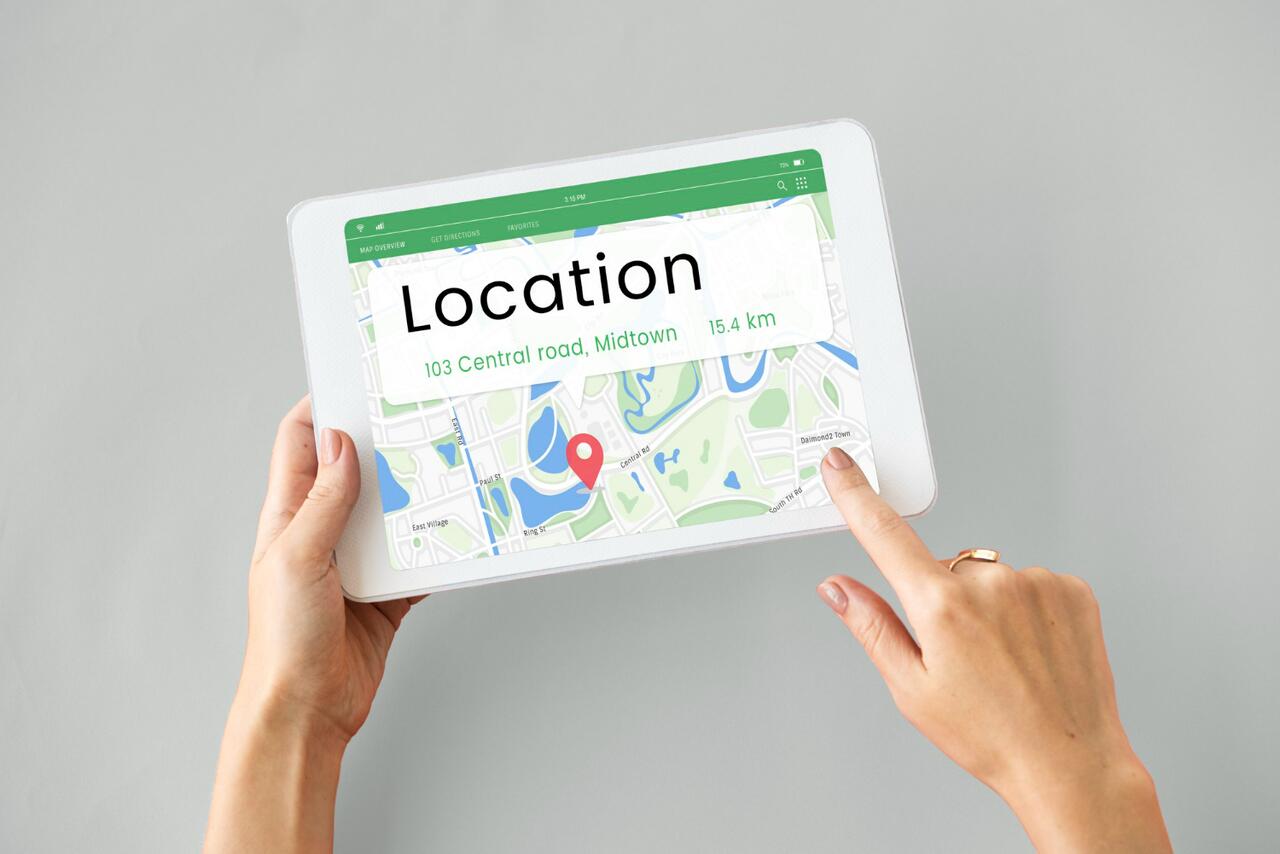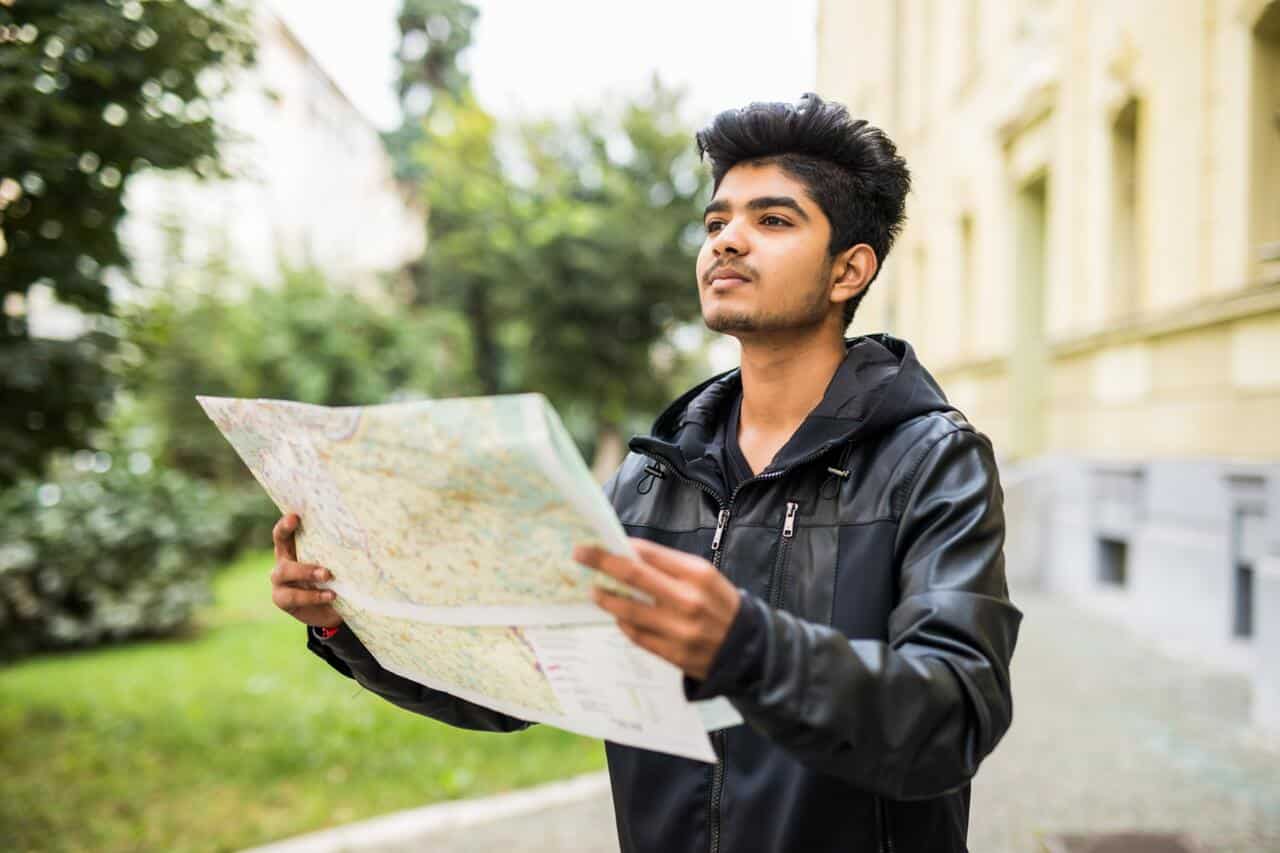
How to Easily Ask for Directions in Spanish
DATE:
Knowing how to give directions is crucial, whether you’re traveling to a Spanish-speaking country or simply trying to navigate a new neighborhood. At SpanishVIP, we believe that mastering this skill is not only practical but also a fun way to engage with the Spanish language and culture.
We understand that giving directions in a foreign language can be daunting, but with the right guidance and practice, it can become second nature.
At SpanishVIP, our mission is to provide you with the tools and resources you need to become a confident Spanish speaker, so let’s begin this exciting journey of giving directions together!
In this article, we’ll guide you through the key vocabulary and phrases you need to know to give directions in Spanish. We will cover different scenarios, such as asking for directions and giving directions to a specific place or landmark.
We will also give you tips and tricks to make your directions clear and concise. In short, in this article you will find everything you need to know to give directions with confidence and security – don’t miss it!
Locations And Prepositions In Spanish
Locations and prepositions are important elements in the Spanish language when it comes to giving and receiving directions. In order to describe the location of a place or object, you need to use prepositions to indicate where it is in relation to other things.
Some of the most common prepositions used to describe a location in Spanish are:
|
Spanish |
English |
|---|---|
|
En |
In |
|
Al lado de |
Next to |
|
Detrás de |
Behind |
|
Delante de |
In front of |
|
A la derecha de |
To the right of |
|
A la izquierda de |
To the left of |
|
Cerca de |
Close to |
|
Lejos de |
Far from |
|
Entre |
Between |
|
Hacia |
Towards |
|
Desde |
From |
|
Frente a |
Facing, opposite |
For example, to say “the book is next to the table,” you would say “el libro está al lado de la mesa.” To say “the park is behind the bakery” you would say “el parque está detrás de la panadería”
It is important to note that prepositions in Spanish can change depending on the context and the type of location being described. For example, when describing a location inside a building, you would use “en” (in), but when describing a location outside of a building, you would use “a” (at).
Additionally, when giving directions, it is common to use landmarks as reference points to help the listener understand the location being described. For example, you might say “gira a la izquierda en la esquina del banco” (turn left at the corner of the bank).
Overall, understanding locations and prepositions in Spanish is crucial for effectively communicating and navigating in Spanish-speaking environments.
With practice and a solid understanding of the basics, you can become confident in your ability to give and receive directions in Spanish.

Vocabulary To Ask For Directions In Spanish
Now it’s time to learn Spanish street vocabulary because whether you are asking for directions in Spanish or giving directions in Spanish, you will surely need to name these words in order to formulate your sentence or question well.
So it is important to memorize and know these words in order to begin to understand Spanish directions.
|
Spanish |
English |
|---|---|
|
Calle |
Street |
|
Avenida |
Avenue |
|
Road | |
|
Carretera |
Highway |
|
Camino |
Path |
|
Plaza |
Square |
|
Paseo |
Promenade |
|
Pasaje |
Passage |
|
Calzada |
Roadway |
|
Rambla |
Boulevard |
|
Sendero |
Trail |
|
Ronda |
Ring road |
|
Callejón |
Alleyway |
|
Travesía |
Crossing |
|
Calle Principal |
Main street |
|
Calle Secundaria |
Side street |
|
Bulevar |
Boulevard |
|
Glorieta |
Roundabout |
|
Zona peatonal |
Pedestrian zone |
|
Acera |
Sidewalk |
Verbs To Talk About Directions In Spanish
When talking about directions in Spanish, there are several key verbs that you will need to know in order to give and receive directions effectively. Here are some of the most important verbs for giving directions in Spanish:
Ir – to go
Ve por esta calle hasta el semáforo y luego gira a la izquierda
Go down this street until the traffic light, and then turn left
Estar – to be
El museo está en la calle principal, cerca de la plaza
The museum is on the main street, close to the square
Llegar – to arrive
Para llegar al restaurante, debes cruzar el puente y continuar recto
To arrive at the restaurant, you must cross the bridge and continue straight ahead).
Cruzar – to cross
Cruza la calle en el semáforo y sigue derecho
Cross the street at the traffic light and go straight ahead
Doblar – to turn
Dobla a la derecha en la próxima esquina y sigue por dos cuadras
Turn right at the next corner and continue for two blocks

Seguir – to follow
Sigue este camino hasta el final y luego gira a la izquierda
Follow this path to the end and then turn left
Subir – to go up
Para llegar al mirador, debes subir las escaleras
To get to the viewpoint, you must go up the stairs
Bajar – to go down
Para llegar a la estación de metro, debes bajar las escaleras
To get to the subway station, you must go down the stairs
Pasar – to pass
Después de pasar el parque, verás el cine a tu derecha
After passing the park, you will see the movie theater on your right
Tomar – to take
Toma el autobús número 15 hasta la última parada
Take the bus number 15 to the last stop
These verbs are essential for giving clear and accurate directions in Spanish. When combined with prepositions and landmarks, they can help you navigate your way through any Spanish-speaking environment with confidence.
How To Ask For Directions In Spanish
When asking for directions, especially to strangers, it is very important to approach the person being polite and cordial, so we must also know a little about the formal language and greetings in Spanish.
We can use the phrases approaching the person with “Disculpa…” (Excuse me…), “Perdón…” (another way to say “excuse me”), or “Buenos días / Buenas tardes…) (good morning / afternoon…).
Now, let’s see the most common questions in Spanish to ask for directions that you need to know:
|
Spanish |
English |
|---|---|
|
Disculpa, ¿podrías ayudarme? |
Excuse me, could you help me? |
|
¿Podrías decirme dónde está…? |
Could you tell me where…is? |
|
Perdón, ¿sabrías cómo llegar a…? |
Excuse me, would you happen to know how to get to…? |
|
¿Me podrías indicar cómo llegar a…? |
Could you show me how to get to…? |
|
Buenas tardes, ¿me podría ayudar con una dirección? |
Good afternoon, could you help me with a direction? |
|
¿Podrías indicarme cómo llegar a la calle X? |
Could you tell me how to get to X street? |
|
Disculpe la molestia, ¿podría decirme dónde se encuentra la dirección X? |
– Sorry to bother you, could you tell me where the address X is located? |
|
¿Puedo usar el transporte público para llegar a…? |
Can I use public transportation to get to…? |
|
¿Está lejos de aquí…? |
Is it far from here…? |
|
¿Cuál es la mejor manera de llegar a…? |
What is the best way to get to…? |
|
¿Hay un mapa que pueda usar para encontrar mi camino? |
Is there a map I can use to find my way? |
|
¿Hay algún punto de referencia que pueda buscar para llegar a…? |
Are there any landmarks I can look up to get to…? |

Let’s see a conversation example!
–Hola, ¿podrías decirme dónde está el hospital cerca de aquí, por favor?
-Hi, could you tell me where the hospital is near here, please?
-Está cerca de la plaza principal. Ve hacia la derecha en la primera calle.
-It is close to the main square. Turn right at the first street.
-Creo que entendí bien, ¿giro a la derecha en la primera calle?
-I think I understood correctly, do I turn right at the first street?
-Sí, exactamente. Luego, sigue caminando hasta llegar a la parada de autobús. A lo lejos verás unas escaleras.
-Yes, exactly. Then keep walking until you reach the bus stop. In the distance you will see some stairs.
-Gracias, ¿y dónde están las escaleras? ¿En la misma calle o debo cruzar?
-Thank you, and where are the stairs? On the same street or should I cross?
-Después de la parada de autobús, las escaleras estarán a tu izquierda.
-After the bus stop, the stairs will be on your left.
-Puedes hablar más de espacio, por favor.
-Can you speak slower, please?
-Claro. Es muy fácil. Después de la parada de autobús, las escaleras estarán a tu izquierda.
-Sure. It’s very easy. After the bus stop, the stairs will be on your left.
-¡Gracias por su ayuda!
-Thank you for your help!
-De nada. ¡Buena suerte!
-You’re welcome, please. Good luck!
Now You Are Ready To Talk About Directions In Spanish!
Mastering the art of giving and understanding directions in Spanish is an invaluable skill for anyone seeking to truly immerse themselves in the language and culture.
As we’ve explored throughout this blog, learning to give directions in Spanish involves not only expanding your vocabulary list but also sharpening your listening skills and becoming familiar with various formal and informal expressions.
By practicing example sentences such as “en la esquina,” you’ll gradually build up your confidence in speaking Spanish and be better equipped to navigate your surroundings or assist others in finding their way.
Additionally, by engaging in conversations with native speakers and utilizing common phrases, you’ll refine your communication skills and discover new vocabulary that may not be found in a typical textbook.
One of the key aspects of learning to give directions in Spanish is understanding the subtle differences between formal and informal language.
For instance, when providing directions to a restaurant, you may choose to use a more formal tone with a stranger, while adopting a casual approach with a close friend.
By becoming well-versed in both formal and informal expressions, you’ll be prepared to interact with a wide range of Spanish speakers in various situations.
As you continue to learn Spanish, don’t forget to practice example sentences and incorporate them into your daily conversations. This will help you become more comfortable with the language and better understand the nuances of giving and receiving directions.
Also, remember to pay attention to your surroundings and listen to how native speakers provide directions, as this will further enhance your comprehension and speaking abilities.
Finally, always be open to asking for help when you need it. Don’t be afraid to approach a native speaker and say, “gracias por tu ayuda” when they provide you with valuable information.
This not only demonstrates your appreciation but also encourages further language practice and growth.
In summary
Learning to give directions is an integral part of your journey to fluency. By dedicating time and effort to understanding the vocabulary and expressions associated with directions, you’ll soon be able to confidently navigate your way around a Spanish-speaking environment, whether you’re searching for a restaurant or simply exploring new places.
And remember that if you want to start studying Spanish as a second language, you should make sure you are taught by native teachers and professionals in teaching Spanish.
So we invite you to try a free 1:1 class or free 7 days of group classes and discover why the SpanishVIP methodology is so successful for hundreds of students!








